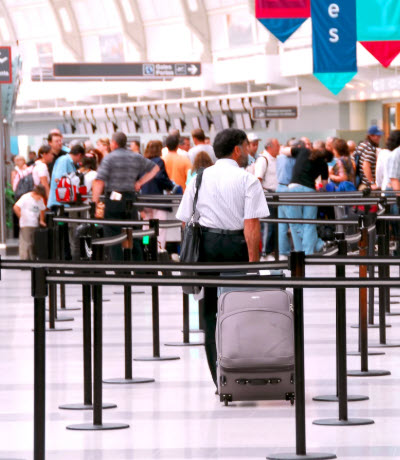Flying During the Shutdown?
10 October 2025
In case you haven’t heard, the US federal government has shut down. If you have flights booked, you need to know what’s happening.
TSA agents, air traffic controllers, and customs officers are classified as “essential” and must continue working, but they won’t receive paychecks until the shutdown ends. History shows this creates serious problems: during the 35-day 2018-2019 shutdown, TSA sick calls doubled, some airports had to close security checkpoints entirely, and flight delays cascaded throughout the system.
Travelers are already experiencing longer security lines, extended customs waits, more flight delays, and increasing reports of lost luggage and forced gate checks. Airlines are still selling tickets because flights can technically operate, but “can operate” and “will operate smoothly” are very different things.
The question isn’t whether there will be disruptions – it’s whether your trip is worth navigating them.
If you’re traveling during this shutdown, you need a solid game plan to minimize stress, avoid getting stuck at the airport, and protect yourself from the worst-case scenarios. Here’s exactly what to do – and when to consider staying home instead.

Before you leave: essential preparation
The key to surviving airport chaos during the shutdown is preparation. While you can’t control airport staffing levels or air traffic delays, you can control how ready you are to handle them.
Check Your Flight Status Early and Often
Starting 24 hours before departure, monitor your flight on FlightAware.com, which provides real-time tracking and delay predictions. FlightAware shows you the aircraft’s previous routes – if the plane coming to pick you up is already delayed three cities back, you’ll know trouble is coming before the airline announces it.
Also watch your airline’s app for delay notifications.
Check In Online at Exactly 24 Hours
Set an alarm for exactly 24 hours before departure – this is when most airlines open online check-in. Checking in early gives you priority if the flight becomes oversold. Passengers who check in last are the first to get bumped. Get your mobile boarding pass immediately and save it to your phone’s wallet app.
Confirm or Purchase Your Seat Assignment
If you don’t have a confirmed seat, select one during check-in – even if you have to pay for it. Airlines prioritize passengers with assigned, paid seats when managing oversold flights. A $20-30 seat fee can save you from getting bumped or stuck overnight at the airport.
Research Your Backup Flights Now
Before travel day, identify alternative flights in case yours gets canceled. Check your airline and its partner airlines in the same alliance (Star Alliance, OneWorld, or SkyTeam). Save alternative flight numbers and departure times in your phone notes because when chaos hits, seats disappear fast, and you don’t want to research options while standing in a rebooking line with 200 other passengers.
Perfect Your Carry-On Strategy
Don’t check a bag during the shutdown. Weigh and measure your carry-on when fully packed and verify it meets your specific airline’s size restrictions. Pack a change of clothes, medications, valuables, and toiletries in your personal item as backup in case you’re forced to gate-check your carry-on.
Pack Smart for Extended Delays
Bring extra snacks, a refillable water bottle, phone chargers, and entertainment for potential long waits. Download movies, books, or podcasts before you leave home – airport Wi-Fi can be unreliable. Pack any essential medications in your personal item so they’re always accessible. If you end up stuck at the airport for hours, you’ll be glad you did.
Pro tip: Look at the airport’s website to find interesting things to do or see. Some airports have art installations or interesting decks where you can watch the planes. This will reduce boredom as you wait.
Add Extra Time to Your Airport Arrival
Add at least one hour to your usual airport arrival time, even if you have TSA PreCheck. TSA has already warned that prolonged shutdowns lead to longer security lines. For international flights, add even more time for customs delays.
My guess is that you’d rather wait at the gate than miss your flight because security took 90 minutes instead of 20.
At the Airport
You’ve done your prep work – now it’s time to execute. These strategies will help you move through the airport efficiently and avoid the most common shutdown-related problems.
Skip the Check-In Desk Entirely
Head straight to security with your mobile boarding pass. If you couldn’t check in online, use a self-service kiosk to print your boarding pass. Avoid speaking with check-in agents unless absolutely necessary – you don’t want them scrutinizing your carry-on or wasting time in long check-in lines. If you have your boarding pass, you can bypass the desk completely.
Get Through Security Strategically
Have your ID and boarding pass ready before you reach the checkpoint.
Note: Some airports now only require an ID, but just in case that’s not the case for your airport, have your boarding pass handy.
If you’re not in the TSA PreCheck line, listen to the instructions and follow them quickly to keep the line moving. The TSA agents are short of staff right now and may be short on patience too!
Board the Second Your Group Is Called
When delays and cancellations pile up, passengers get shuffled to other flights. That means the planes are more packed than usual. Overhead bin space disappears fast, and late boarders are often forced to gate-check their bags. Board immediately when your group is called to secure your overhead space.
Stay Connected and Informed
Keep your phone charged and the airline app open with notifications turned on. Gate changes and delays can happen suddenly during irregular operations. If you see a delay or cancellation posted, start working your backup plan immediately.
Know Where to Go If Things Go Wrong
When you arrive at the airport, locate your airline’s customer service desk. Better yet, look it up before you leave home.
If your flight gets canceled, you’ll know exactly where to go instead of wandering around in a panic. Also, identify which gates your backup flights depart from. Knowing where to run can save precious minutes if you need to rebook quickly.
Pro tip: Communicating with the airline staff through the chat in their app is typically the most efficient way to get help. Best to do it from the customer service line just to cover all your bases!
When/If Things Go Wonky
Despite your best preparation, flights may still get delayed or canceled during the shutdown. Here’s how to handle disruptions quickly and protect yourself from getting stranded.
Act Fast When You See a Problem
The moment you see a delay or cancellation notification, start rebooking immediately. Don’t wait for an announcement or for the airline to contact you. Use multiple channels simultaneously—call the airline while using their app and walk to the customer service desk. The first passengers to request rebooking get the best options. Every minute you wait, available seats disappear.
Come Prepared with Specific Solutions
Don’t wait for the gate agent to search for options – tell them exactly what you want. Pull out your phone notes with those backup flight numbers you researched and say, “Can you put me on Flight 1234 departing at 3:15 PM?”
Agents appreciate passengers who know what they want, and you’ll get rebooked faster. Also ask about partner airline options if your airline’s flights are full.
Know What Airlines Owe You (and What They Don’t)
Airlines must rebook you on the next available flight at no charge if the delay or cancellation is their fault (mechanical issues, crew problems). Things could get sticky if they blame the government shutdown, which could be considered outside of their control, and therefore not their fault.
Understand Your Travel Insurance Coverage
Most standard travel insurance policies do NOT cover cancellations or delays caused by government shutdowns unless you purchased a “Cancel for Any Reason” policy before the shutdown was announced. However, your policy may cover additional expenses like hotels and meals if you’re stranded due to covered reasons. Please look over your policy details now and save the claims phone number in your contacts.
Know When to Cut Your Losses
Sometimes the most intelligent decision is abandoning your trip entirely. Calculate whether the trip is still worth it if your flight is canceled and the next available option is 2-3 days away. Consider the cost of extra hotel nights, meals, and the vacation time you’ll lose waiting at the airport. Going home might be the better choice if you’re traveling for a time-sensitive event and won’t make it.
Damian Tysdal is the founder of CoverTrip, and is a licensed agent for travel insurance (MA 1883287). He believes travel insurance should be easier to understand, and started the first travel insurance blog in 2006.
